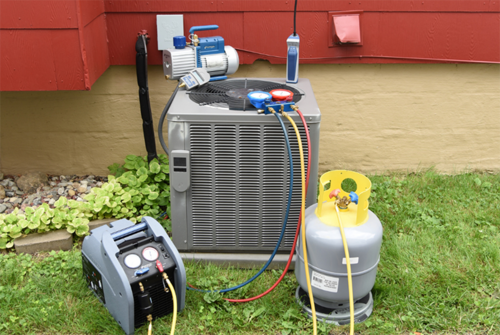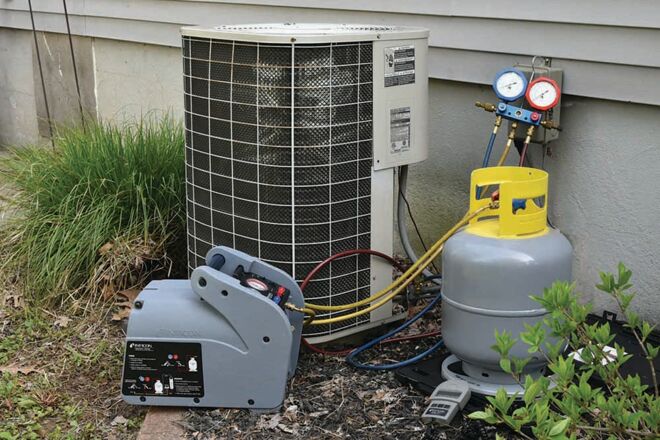HVAC/R Refrigerant Leak Detection
The whys, hows, and the basics for identifying and repairing leaks.

Why is leak detection important?
- System efficiency: Refrigerant is a key component of an AC system. When a refrigerant leak is present, your AC system loses the ability to cool or heat effectively.
- Environmental impact and compliance: Refrigerant can contribute to ozone depletion or global warming if released into the atmosphere. Each refrigerant has three ratings: GWP, CO2e, and ODP. The global warming potential (GWP) measures how much heat a specific gas can retain in the atmosphere. The CO2 equivalent (CO2e) equates the refrigerant's global warming potential to the amount of CO2 it would take to retain the same amount of heat. Lastly, the ozone depletion potential (ODP) is a rating of the refrigerant's ability to destroy the ozone in the stratosphere, reducing the stratosphere's ability to absorb the sun's ultraviolet radiation.
U.S. Regulations: The Environmental Protection Agency (EPA), through Section 608 of the Clean Air Act, has mandated that proper leak detection and repair must be carried out by individuals servicing, maintaining, repairing, or disposing of air conditioning and refrigeration equipment to minimize environmental harm. Technicians are required to pass an EPA-approved exam to obtain a Section 608 certification.
E.U. Regulations: The European F-Gas Regulation aims to reduce emissions of fluorinated greenhouse gases (F-gases) used in refrigeration, air conditioning, and other industrial applications. By phasing down the use of these refrigerants, the regulation encourages the transition to more sustainable alternatives and improved leak detection and recovery practices. These measures support the EU’s broader climate goals and promote innovation in environmentally responsible technologies. EN14624 certification is also required to ensure a leak detector meets the European standard for performance, reliability, and sensitivity when detecting refrigerant gases. Leak detectors must be able to detect at least a 5-gram-per-year leak, and they must be recertified to this standard on an annual basis. Instruments that comply with EN 14624 ensure accurate, consistent leak detection in accordance with the requirements of the F-Gas Regulation, helping technicians maintain compliance and minimize environmental impact.
- Cost implications: A system that has a low refrigerant charge causes the components to work harder, consume more energy, and wear quicker, potentially leading to premature failure and expensive repairs.
Detecting and Repairing Refrigerant Leaks
1) Look out for and identify symptoms of a leak.
- Poor system performance: Reduced cooling or heating capacity.
- High energy bills: A system that is low on refrigerant works harder, consuming more energy, particularly the compressor.
- Visual inspection: Look for visible signs of leaks. Inspect refrigerant lines and connections for oil stains, corrosion, ice buildup, or visible damage. Check evaporator and condenser coils for signs of damage or wear.
Note: It is important to understand the problem—how much refrigerant has leaked (if any), how long has it been leaking, is there still refrigerant in the system, and what type of refrigerant is in the system are all good questions a technician should consider.
2) Monitor system performance—deviations in certain parameters often indicate a loss in refrigerant charge.
- Check superheat and subcooling for inconsistencies, while referring to manufacturer specifications.
- Ensure system pressure aligns with manufacturer specifications by using a pressure gauge.
3) Use leak detection tools.
- Electronic refrigerant leak detectors: This is the most efficient method of leak detection. They detect trace amounts of refrigerant and can help pinpoint the exact leak location(s). There are a handful of different electronic leak detector technologies to choose from. INFICON offers a comprehensive line of leak detectors including infrared, heated diode, and ultrasonic. Learn more about our line of leak detectors here.
- Ultrasonic leak detectors: Ultrasonic leak checking can be helpful in non-traditional applications or in windy or noisy environments, since the tool is listening for a leak instead of sniffing for it. To learn more about ultrasonic leak testing and if it's right for your application, check out our article here.
- Soap bubbles: While less sensitive than electronic leak detectors, this method can help identify larger leaks. It is inexpensive, but it is not as effective. Soap bubbles can be useful for verifying and confirming a leak location after detection with an electronic leak detector.
- UV dye: This method involves injecting dye into the system to identify leaks externally. The dye circulates with the oil and becomes visible under UV light at the leak point(s). This approach requires time for the dye to distribute throughout the system.
Note: Always confirm the source of the leak before performing repairs. Recheck the suspected area with your chosen detection method. You can pressurize the system with nitrogen or forming gas (95% nitrogen/5% hydrogen) to perform a pressure decay test, ensuring no additional leaks exist.


4) Repair the leak.
- Tighten loose fittings or connections as needed.
- Replace damaged components, such as refrigerant lines, valves, coils, etc. to prevent further refrigerant loss (recover refrigerant from system before replacing components or making major repairs).
5) Evacuate, recharge, and test.
- Recover any remaining refrigerant from the system into a refrigerant recovery cylinder using a refrigerant recovery machine.
- Pull a vacuum on the system using a vacuum pump. This eliminates air and moisture from the system, which are known to negatively impact efficiency and possibly cause damage to the system. See manufacturer specs for recommended vacuum level (usually around 400–500 microns). A vacuum gauge is used alongside the pump to monitor vacuum level. If you are struggling to achieve a vacuum level below 5,000 microns, this could be an indication that a leak is present, either in the system or the hoses. Proper setup, operation, and maintenance of the vacuum pump will ensure success with this step.
- Recharge the system with the correct refrigerant and quantity. Use a refrigerant recovery machine and a refrigerant charging scale to ensure precise charging.
- Retest for leaks and verify system performance (P&T).


It is important to address refrigerant leaks promptly, as it helps ensure system efficiency, prevents unnecessary harm to the environment, ensures compliance with EPA regulations, and avoids costly equipment failure/downtime. For a closer look at INFICON tools for HVAC service, please visit our HVAC/R tools page here.